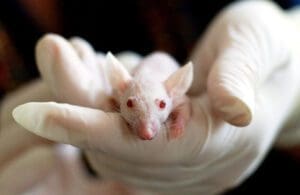
[Photo by Pixabay]
In September, the U.S. Senate unanimously passed the FDA Modernization Act 2.0, which would lift an 84-year-old federal mandate for animal testing for toxicity studies. While the bill doesn’t ban animal testing outright, it would allow drug developers to use alternatives when feasible.
The Senate has sent the bill, also known as S. 5002, to the House. Senators Rand Paul (R‑KY) and Cory Booker (D‑NJ) co-sponsored the bill. The bill has good odds of passing the House before the end of the year, according to a WSJ op-ed.
To learn more about alternatives to animal testing in drug development, we reached out to Susan Murphy, the president of Molecular Devices, which works to enable high-throughput organoid research for life scientists.
What does the transition away from animal testing mean to you?

Susan Murphy
Murphy: So not only is going away from the animal models the right thing to do socially but being able to do drug discovery and drug development on a human model with a human organoid or cells would open up the drug discovery pipeline. As a result, hits, targets, compounds and drugs could get to patients sooner.
Everyone’s trying to get a drug to market. And right now, only one out of 10 in oncology, for instance, is getting through the clinic.
Technology such as organoids can also help get a drug to market much more affordably. Now, it costs billions of dollars and about 15 years to get a drug to market.
Look at the way drug discovery is done with animal testing. There are about 7,000 rare diseases, and only 400 are being actively researched because there’s no animal model. Many diseases aren’t being investigated because there aren’t models that work toward those target areas.
Our customers are working on 3D organoid discovery using human-differentiated cell lines and tissue. That will allow us to give more physiologically relevant or translatable data output that is more like what would happen in a human.
Organoids will open up industries that are not there today. It will enable different therapeutic areas of how people do drug discovery. It’s exciting.
The FDA is saying you no longer have to use animal models to get a drug to market.
Our customers, such as Roche and Merck, have also said they will stop using animal models. They want to do that because they can start using new models that are more physiologically relevant to humans.
We also have academic customers looking to do this as well as those in the pharma/biotech industries.
Where do you think organoid adoption is today?
Murphy: It’s early. 3D models are more predictive of what will happen in humans, as you can imagine. But it’s still early days because our customers tell us the hardest part about using organoids is reproducibility and scalability. It takes time to grow cardioids or lung- or brain-based organoids. Molecular Devices is helping customers scale that process using our hardware and software to automate in a high throughput manner to create or develop organoids. We’re also helping them screen the organoids early in the drug discovery process.
Organ-on-a-chip is a low throughput way of testing. It’s on a low scale and low volume.
We’re trying to help our customers have reproducibility at a higher volume so that they can do up to 1000 compounds per screen.
Can you talk about the demand you’ve received from customers for organoids?
Murphy: It continues to increase. Molecular Devices has high-content imaging systems and solutions where our customers want to read organoids. About five years ago, it was about 10% of our customers. And today, typically, 75% of our customers are looking at our high-content imaging systems. Maybe they’re not doing organoids now, but they say they want to be able to do them. The market is definitely shifting in that direction and looking for solutions to develop and screen organoids to help address those pain points of reproducibility and scalability.
Roche has said publicly that they’ve reduced the use of their animals by 40% over the last 10 years.
Imagine if you could use human cells earlier in the drug discovery process, whereas people today are using CHO and HeLa cells. They’re not human cells. If you do drug discovery on human cells, you will have much more physiological translatable data much earlier in the process and be able to get it to the clinic sooner.
We are working with a company called HeartBio.bio to develop a cardioid toxicology assay — a cardiac organoid. Toxicology is an essential part of the testing as you go to clinical trials before you get to clinical trials. They have a patent-protected way to develop cardioids that have three chambers. Think of it as a mini heart that can be used for toxicology. So not only are we looking at utilizing organoids early on that are more humanly translatable and more physiologically relevant in the drug discovery process and pipeline, but you can use cardiac organoids to test for toxicology versus testing in a mouse or other animals.
That is also a big game changer for the industry because you could be testing toxicology much earlier. So it will be a game changer for our drug discovery customers and the drug discovery pipeline.
How do you see drug development evolving in the coming years?
Murphy: Some people tell me small molecule is dead. It’s not dead. People are still screening compounds and looking for small molecules.
We are looking at a paradigm shift with organoids. Not only will it allow us to get drugs to the clinical trials and the FDA faster, but we’re also going to be able to look at diseases that we weren’t even able to target. We’re only looking at 400 of the 7,000 diseases we know today.
Look at the work we’ve been doing for the last 20 years with CRISPR, stem cells, hardware and software, pulling it all together. So it’s a really exciting time for our customers.
Think about the pictures you can take on your phone. Now we’re using that kind of technology inside our systems. We’re reading through tissue to know what’s going to stop cancer or not.
I don’t feel like the pandemic is driving more innovation. However, the pandemic made it seem like everyone was working on vaccines simultaneously. It was an interesting experiment for us and the industry. It helped people think about how we can look at things differently. That could mean partnering with other people. People can partner with academics looking to fill different parts of their pipeline, but they’re doing more of that now, and looking for more partnerships.
As a woman CEO, what do diversity and inclusion efforts mean for Molecular Devices?
Murphy: I appreciate you asking because I’m absolutely driving diversity, inclusion and belonging. That’s a huge focus for us at Molecular Devices. We are always trying to help promote women in science. I see a lot more diversity, which is essential to our business. Women have been in science, but they haven’t always been heard. There are a lot of famous scientists that are women scientists that you hear about after the fact. For that reason, making sure that people have a voice in our industry is important. I see a shift in that, and that’s a great shift.